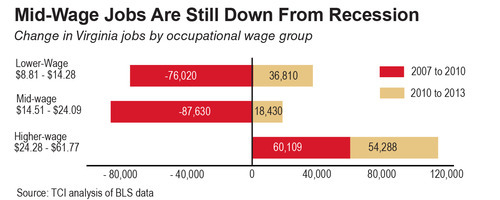August 14, 2014
Opportunity’s Broken Ladder
To climb the ladder of success in the working world, you need enough rungs to get you from the bottom to the top. Yet if we look at where job growth in Virginia has been strongest, it’s at the upper and lower ends of the wage scale, while the jobs in the middle have gone missing.
That makes it harder for people to climb out of low-wage jobs, since the next rungs on the ladder are missing.
Middle-wage occupations – those that have median wages between $14.51 and $24.09 per hour – lost over 87,000 jobs between 2007 and 2010. But they have regained just over 18,000 jobs between 2010 and 2013. The lowest-paying occupations also suffered significant job loss during the recession, and while they’ve recovered a larger share of these jobs, they’re still below pre-recession levels, too. Only Virginia’s highest-wage occupations, which grew in employment even during the recession, have seen net growth in jobs since 2007.

Collapsing job opportunities in the middle create major challenges for Virginia’s middle class families. Jobs in high-wage occupations may not be easily accessible to workers displaced from the middle, since they may not have the skills or education required for those jobs. Instead, these workers may be forced into lower-paying jobs. And without opportunities to get a foothold in the middle, workers at the bottom can’t very well work their way to the top.
Creating more and better middle wage jobs is essential to building a stronger economy where Virginia’s businesses, communities, and families can thrive, and the ladder to success offers hard-working people a real chance at climbing up.
–Laura Goren, Policy Analyst
